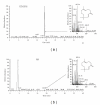Activations of Both Extrinsic and Intrinsic Pathways in HCT 116 Human Colorectal Cancer Cells Contribute to Apoptosis through p53-Mediated ATM/Fas Signaling by Emilia sonchifolia Extract, a Folklore Medicinal Plant
- PMID: 22474491
- PMCID: PMC3303801
- DOI: 10.1155/2012/178178
Activations of Both Extrinsic and Intrinsic Pathways in HCT 116 Human Colorectal Cancer Cells Contribute to Apoptosis through p53-Mediated ATM/Fas Signaling by Emilia sonchifolia Extract, a Folklore Medicinal Plant
Abstract
Emilia sonchifolia (L.) DC (Compositae), an herbaceous plant found in Taiwan and India, is used as folk medicine. The clinical applications include inflammation, rheumatism, cough, cuts fever, dysentery, analgesic, and antibacteria. The activities of Emilia sonchifolia extract (ESE) on colorectal cancer cell death have not been fully investigated. The purpose of this study explored the induction of apoptosis and its molecular mechanisms in ESE-treated HCT 116 human colorectal cancer cells in vitro. The methanolic ESE was characterized, and γ-humulene was formed as the major constituent (63.86%). ESE induced cell growth inhibition in a concentration- and time-dependent response by MTT assay. Apoptotic cells (DNA fragmentation, an apoptotic catachrestic) were found after ESE treatment by TUNEL assay and DNA gel electrophoresis. Alternatively, ESE stimulated the activities of caspase-3, -8, and -9 and their specific caspase inhibitors protected against ESE-induced cytotoxicity. ESE promoted the mitochondria-dependent and death-receptor-associated protein levels. Also, ESE increased ROS production and upregulated the levels of ATM, p53, and Fas in HCT 116 cells. Strikingly, p53 siRNA reversed ESE-reduced viability involved in p53-mediated ATM/Fas signaling in HCT 116 cells. In summary, our result is the first report suggesting that ESE may be potentially efficacious in the treatment of colorectal cancer.
Figures







References
-
- Center MM, Jemal A, Smith RA, Ward E. Worldwide variations in colorectal cancer. CA Cancer Journal for Clinicians. 2009;59(6):366–378. - PubMed
-
- Tan KY, Liu CB, Chen AH, Ding YJ, Jin HY, Seow-Choen F. The role of traditional Chinese medicine in colorectal cancer treatment. Techniques in Coloproctology. 2008;12(1):1–6. - PubMed
-
- Hu B, Shen K-P, An H-M, Wu Y, Du Q. Aqueous extract of curcuma aromatica induces apoptosis and G2/M arrest in human colon carcinoma LS-174-T cells independent of p53. Cancer Biotherapy and Radiopharmaceuticals. 2011;26(1):97–104. - PubMed
-
- Cao B, Li ST, Li Z, Deng WL. Yiqi Zhuyu Decoction Combined with FOLFOX-4 as first-line therapy in metastatic colorectal cancer. Chinese Journal of Integrative Medicine. 2011;17(8):593–599. - PubMed
-
- Cheng WY, Wu SL, Hsiang CY, et al. Relationship between San-Huang-Xie-Xin-Tang and its herbal components on the gene expression profiles in HepG2 cells. American Journal of Chinese Medicine. 2008;36(4):783–797. - PubMed
LinkOut - more resources
Full Text Sources
Research Materials
Miscellaneous

